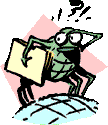Hi Hill Brat, I bet you haven't heard that lately. It was great to hear from you. I would be glad to work with you any way I can. I have some archived material that I will dig up. Somewhere I have some audio tapes of interviews with old timers by a researcher from Cisco State. I will try to find them and get duplicates. One of my projects is to transfer my records to CDs. I hope to transfer those tapes to CDs one of these days. As for my background (remember, you asked for it), in Jan. 1951 I was looking for a job as a mathematician when I wound up at Northrop Aircraft Co. They asked, "How would I like to become a computer programmer?" I asked them, "What was a computer and what was a programmer?" They told me and I became one. My first computer was BINAC, a computer designed and manufactured by Eckert/Mauchley. BINAC was after ENIAC and before UNIVAC. It had a serial mercury delay line memory of 512 32 bit words, binary input and output, tape storage. One of the engineers wired an IBM 010 keypunch to be used as an octal input device. So every thing we input and output was in octal. All code was written in absolute machine language and our book of computer operations was a logic diagram. There were 32 instructions. BINAC was the first stored program computer in the US. At Northrop I also worked on the IBM 407 and the IBM CPC. I went to North American Aviation in 1953 to work with the IBM 701. In 1956, I was one of four from NAA to go back to IBM in NY to check out the NAA Operating System for the IBM 704. We had developed a peripheral system where the input/output was on tape. The tape-to-printer crashed and we were stuck with 19 tapes with our debugging output on them. They put one of our operations people in a limo and drove him and the 19 tapes to Armock where the tapes were printed. DeCarlo made a mistake when he asked me how things were going. When I told him that the peripheral equipment is as necessary as the main frame when you are operating in a peripheral mode, he replied that they had no idea that anybody would use it like we were. What did he think we were supposed to use it for? I worked in Frank Wagner's (the Father of SHARE) group who were consultants to the engineers who did their on programming in an Open Shop environment. Also, we and the Finance Dept. programmers developed operating systems and utilities. In 1961 I went to TRW and retired from there in 1991. CS Dominguez Hills started a program to take retired engineers and train them to get a California secondary teaching credential. 18 of us old codgers enter in 1992 and 6 of us obtained credentials. 3 took full time teaching jobs and 3 of us became substitutes. I was a sub in math at PVPHS for 10 years. Last year my credential had to be renewed. That required 150 professional hours within a 5 year period. Those are acquired via district workshops and subs are not eligible, so I gave up subbing. I hold computer workshops at Palos Verdes on the Net computer center every Thursday afternoon, so I am keeping active. No that I have bored you out of your mind, I will sign off. roger
|
|||||||||
